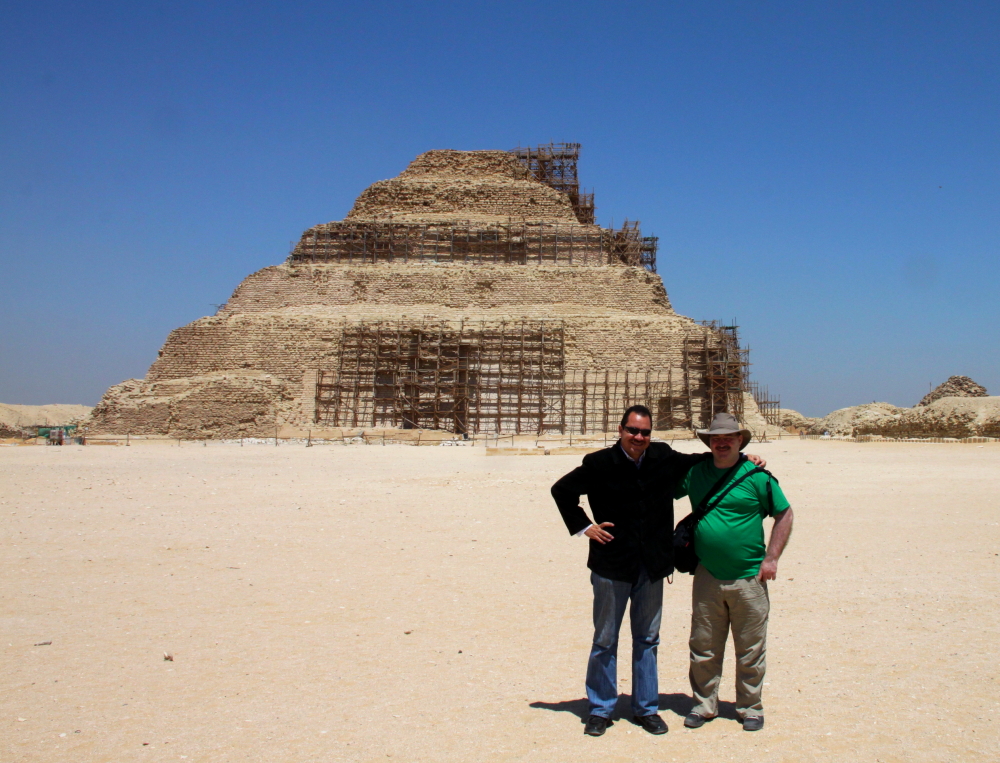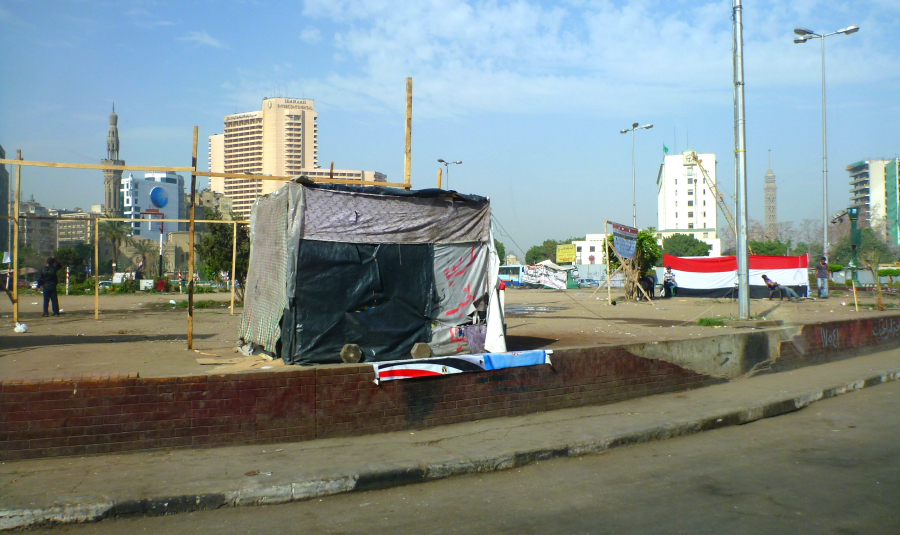Planning Our Trip
We had decided since we returned from our trip to China in October 2010 – our next big trip would be a visit to Egypt. In January 2012 we made the decision to go in the spring. We picked late April. Any later, the risk was that Egypt would be too hot. Any earlier, it would be hard to arrange. Considering some people had mentioned spending a year on planning and arrangements, this was actually pretty short notice – 3 months or less.
We had already done some reading, but now we studied more intensively. At first I thought we could simply go there and wing it from day to day, as we did in China. Further reading and asking people who had been there, we concluded that we needed a guide. Good thing we figured that out. Yes, to see Egypt, you need a guide.
First we looked at brochures, even though neither of us was enthusiastic about big groups. The range of prices was significant, but remember the rule of thumb, you only get what you pay for… There is no great value in going cheap. In almost all cases, the day you arrive and depart should not count as there is no time to do anything.
Prices varied quite a bit; here’s what we found for 2 people. At the low end from $3700 for 15 days, not counting arrival and departure, with Gap Tours. Accomodation was relatively basic – simple twin share, no guarantee of air conditioning even or private bathroom,their “Standard”. Groups could be up to 15 people. The transfer to Jordan appears to be by ferry, which some travellers on various web sites describe as “interesting”. Fly home from Amman, which we could not arrange with our Aeroplan tickets.
The intermediate price was Trafalgar Tours: 10 days from Cairo to Abu Simbel for $4500; minus 2 days for arrival and departure, and note 3 nights are spent on the Nile cruise boats instead of in a hotel. They promise “First Class” accomodations, but no specifics as to how that translates into stars. This worked out to 8 days at $550 a day, and does not even get close to Sharm el Sheik or Petra. Abu Simbel is an extra option; 2 flights – do you think it’s cheap? Insight Vacations offered similarly configured and similarly priced tours.
At the top end of the scale, Globus (globusjourneys.ca) offered 13 days (minus the 2) for $8400. If we wanted to add 3 days, for a Lake Nasser cruise to Abu Simbel, the price jumps to $10,200. This is a 7-day cruise, meaning you stall on the boat from Aswan down to Luxor then back again. Note they quote the supplement for a Giza “room with Pyramid view” as $106 for April departures – per person, shared, so a $212 premium for a pyramid room. This still does not include Sharm el Sheik or Jordan… Travelling on a boat with a hundred other people means that every stop will be as hectic and crowded as the last.
None of these options appealed to us. We searched different online websites too. We looked for recommendations online; we sent out emails to a few with a moderately detailed itinerary. We wanted to drive or fly around the country, we did not want a Nile cruise – it’s not our idea of fun. We wanted to see the sights of the Nile, Sharm el Sheik, Mount Sinai, Petra. We wanted higher quality hotels.
A tour company in New York (recommended by a friend) responsed to our suggested itinerary with “tell us where you want to go”; did they even read the email? One of the tour companies on Egypt was a bit more friendly, but also appeared to reply with a cut-and-paste, in one point refering to a cruise and the next item referring to a road trip.
Our internet reading often brought up the name of Ahmed Hamed Yousif as a recommended guide. Many people had him as their guide in the Cairo area and sang his praises. Eventually it appears he branched out into arranging personal tours for couples and smaller groups; making the complete arrangements, and making sure arrangements went smoothly for the legs of the trip he was not with us. See, for example, Liz and Richard’s trip report which is the first thing I find when I type into Google “Liz and Richard”. Another good report was this one … Beth’s trip report. We read these and said “that’s the trip we want!”
If anyone is considering a similar trip, I am happy to recommend our friend Ahmed. His email is ahmedhayo@yahoo.com

Ahmed Hamed Yousif, our guide, in front of (what esle would it be??) the Pyramids of Giza
So for a bit more than the cost of the top end group tour we spent 18 days in the middle east, or 16 if you subtract arrival and departure. We had our own private van and driver, our own dedicated guide, we got accomodation at 5-star hotels with breakfast, it included several local flights- Cairo-Abu Simbel -Aswan, Luxor-Sharm, Sharm-Amman, and Amman-Cairo.
A private transport meant we arived and left on our schedule; no 15-minute wait for everyone to get off the bus, or half an hour rounding up everyone to get on. We could also be more flexible – “let’s go to this first, or let’s also stop and see that” instead. If we wanted to climb inside a pyramid, or spend a bit more time taking pictures – they wait for us. Many web posters warn you too, that the cheaper tours will waste time taking you to stores where the guide and driver would get a cut of the sales. These are things we avoided with a private guide.
In the end we were not disappointed. We both describe this as the most enjoyable, most relaxing and most worry-free vacation we’ve ever taken. We would gladly repeat it all over again – in fact we hope we can go back in a few years.

Ahmed with me in front of the Step Pyramid at Sakkara. They say the camera adds 10 pounds; since I had 4 cameras with me counting the iPhone and iPad, and technically the iPad had 2 cameras, that is how I explain how I look…
Note that Ahmed does not own a tour company; he makes the arrangements for vehicles, etc. (and we take care of payment by credit card) through one of the larger local Egyptian tour operators. The vehicles were all new looking, typically larger Hyundai vans; and we had no mechanical failures; our drivers were very good and we were not scared, other than the typical “wow they drive like that around here” amazement. Ahmed arranged for a SIM card for my iPhone; he would text or phone us to make sure each leg of our journey was going well. The guides that he arranged for other locations were very good too, particularly Mohammed who showed us around the temples and other sights of the southern Nile from Abu Simbel to Luxor and Abydos. All spoke very good English, and all were very knowledgeable. The best way to see a sight like an Egyptian temple is with a guide who knows his topic and can point out the details and explain them – especially the meanings of the carvings and heiroglyphics on the walls.
What everyone wants to know is “what did it cost?” I don’t want to answer that because – every trip is different, if I say “it cost $X” someone will complain if next year it costs more; our trip included some special extras like a balloon ride; tourism is down because of (unfounded) fears in the west after the revolution, so 5-star hotels are likely a lot cheaper than they will be when things are settled down; and of course, prices vary by season too. Plus, we took a lot for tipping, and probably were over-generous (we hope so) since the tourism business is so slow right now. We do not generally see any appeal in fancy restaurant meals, often we had a small room service meal instead, so we saved money that way.
IS IT SAFE?
Finally, when we said we were going to Egypt, we got two reactions. Half the people said “that’s my dream trip” and half said “won’t you get killed”? People who see the occasional CNN reports confuse it with Libya, Syria, or other middle eastern places in turmoil. It is not. Occasional serious upsets – like the soccer riot that killed 70 – are very isolated and did not repeat. Even during the absolute worst political riots, deaths were limited to a handful. According to western media, Tahrir Square is a zone of flying rocks, bullets, and tear gas. We drove through it, and there was almost nobody there – just a few tents and maybe a dozen “Occupy Tahrir” protesters. The front entrance to the Cairo Museum was open again now that the big demonstrations were over. Cairo is a giant city of 20 million people. Other than the museum, nothing touristy is even close to where people demonstrated. Outside of Cairo itself, very few demonstrations happen.

Tahrir Square – not as wild as seen on CNN
This points out another advantage to having a local driver and guide. They are quicker to recognize if a situation is reaching the point where it is unsafe and time to get out, and will get you out by the best possible route.
The only supposedly unsafe place was the Sinai, where the Bedouins had kidnapped a few foreign tourists. Nobody was threatened or harmed, it was just a way for the local tribes there to get the attention of the government. We joked with Ahmed that “other people pay to have tea with the Bedouins. Maybe we’ll get it for free.” For safety, all travel out of the Mt. Sinai area was with police escort for half the trip, until we were near the coast; so we left St. Catherine’s with a convoy of about 30 vehicles, with a police truck at the front and the back.
The biggest side effect of this “fear factor” was that we had a lot of often crowded attractions very much to ourselves. Places like Abu Simbel, Valley of the Kings, and the pyramids at Giza could sometimes be so full of people you could barely move. Lucky for us, very sad for the locals who depend on the tourism business, we found many places almost empty. We hope for their sake things pick up.
For example, many of the Valley of the Kings tombs have a wood railing down the center of the passages, one side going in, one side going out for traffic control. In several tombs, this was entirely unnecessary – at some points we were the only ones in the tomb. Nowhere did we encounter crowds.
Go see Egypt!

The burned remains of Mubarak’s party headquarters beside the Cairo Museum, the only real evidence of destruction.

Pingback: Gap Tours - Place to travel | Gap Tours
This is my dream trip! Thank you for posting!!